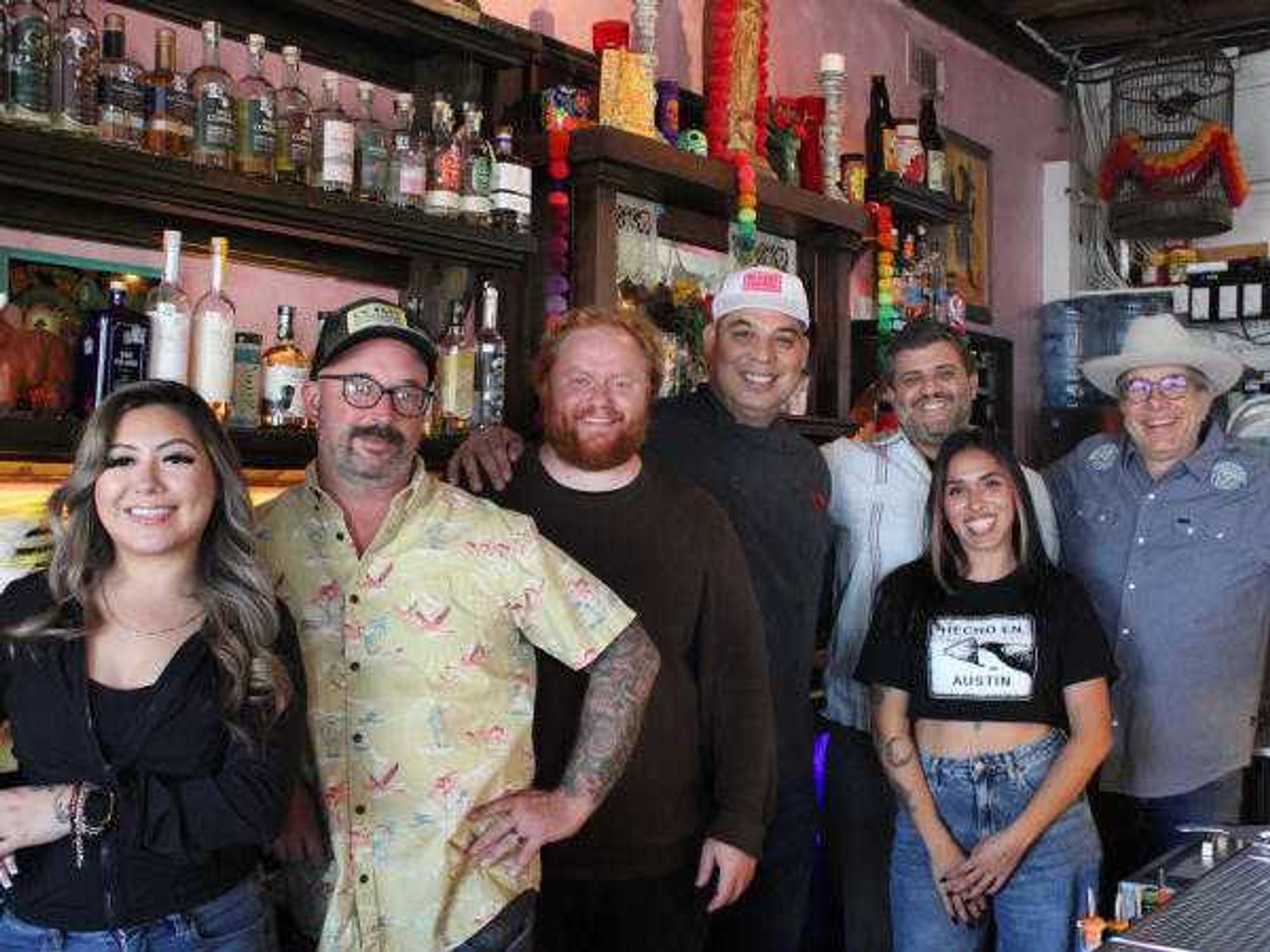Travelin' Man
Where time stands still: Seminole Canyon preserves sense of wonder in lonelycorner of Texas
 This bronze statue stands guard at the rim of Seminole Canyon.Photo by Stephan Lorenz
This bronze statue stands guard at the rim of Seminole Canyon.Photo by Stephan Lorenz Fossils are common along the trail leading toward the shelter.Photo by Stephan Lorenz
Fossils are common along the trail leading toward the shelter.Photo by Stephan Lorenz The three human figures in this photo are one of the more famous paintings inFate Bell Shelter and are well preserved.Photo by Stephan Lorenz
The three human figures in this photo are one of the more famous paintings inFate Bell Shelter and are well preserved.Photo by Stephan Lorenz The guided group hikes into the canyon.Photo by Stephan Lorenz
The guided group hikes into the canyon.Photo by Stephan Lorenz Here are more recent markings left by early settlers.Photo by Stephan Lorenz
Here are more recent markings left by early settlers.Photo by Stephan Lorenz Overhanging rocks provided protection for early inhabitants.Photo by Stephan Lorenz
Overhanging rocks provided protection for early inhabitants.Photo by Stephan Lorenz Animal and abstract shapes abound in the shelter.Photo by Stephan Lorenz
Animal and abstract shapes abound in the shelter.Photo by Stephan Lorenz We're looking out from Fate Bell Shelter in Seminole Canyon.Photo by Stephan Lorenz
We're looking out from Fate Bell Shelter in Seminole Canyon.Photo by Stephan Lorenz The canyon floor is scoured clean by flash floods.Photo by Stephan Lorenz
The canyon floor is scoured clean by flash floods.Photo by Stephan Lorenz The view from the Fate Bell Shelter.Photo by Stephan Lorenz
The view from the Fate Bell Shelter.Photo by Stephan Lorenz
Past Del Rio, the country turned from dry brush to desert. U.S. Route 90 swung west, leaving the city, past Amistad Reservoir — its water low, but still oddly tinged blue among the dull cliffs and arid hills.
It had been a solid six-hour drive from Houston to Del Rio, and we'd welcomed the chance for a break to fill up and grab a snack. West of here, the Chihuahuan Desert sprawled for hundreds of miles — a land of undulating rock, sand and canyons, nearly swallowing the few scattered towns.
Fortunately, we had just under an hour to go before turning south onto the short paved road leading into Seminole Canyon State Park. A brown sign, easily missed, pointed to the left, not offering a hint at the uniqueness of the site.
Before heading back, the ranger asked us to be quiet, sit and linger. I took in the view, listening to the faint wind stirring dry branches in the handful of trees growing among scattered boulders.
We stepped out, stretched our legs and looked across the seemingly smooth and unbroken ocotillo flats. A few paces from the parking lot revealed the first views of Seminole Canyon — a deep gash in limestone running in twists and turns all the way to the Rio Grande, six miles distant.
The ghosts of Texas past
Seminole Canyon State Park, 2,200 sparsely vegetated acres, sits in a lonely corner of Val Verde County near the Rio Grande and Mexican border. These lands have been inhabited for at least 12,000 years, and bones of large bison and mammoth are evidence of a successful hunting culture in a lusher landscape.
After climate changes and drier conditions prevailed, other cultures settled in the area about 7,000 years ago. These people left unique rock paintings in canyons along the Rio Grande, Pecos and Devils Rivers.
We arrived just in time to join one of the daily tours offered at 10 a.m. and 3 p.m. during the winter season. Visitors cannot access the shelter and rock art outside ranger-led hikes in order to protect the fragile paintings.
An overlook near the visitor center offered explanations about the region, and a large bronze statue — its design based on the rock paintings — overlooked the canyon.
What goes down must go up
During the hike down, we learned about edible plants found in the desert. The ranger also pointed out materials used by early inhabitants for basket weaving and making sandals.
The bottom of the canyon was scoured clean by flash floods. Limestone, almost silver in the strong sun, stood out among sand and pebbles. Vertical cliffs rose on one side, while boulder-strewn slopes climbed from the canyon floor on the other.
Ten minutes later, we climbed the short trail to Fate Bell Shelter, where we saw the first paintings, along with more recent markings left by early settlers. Above us, time immortal was visible in colored layers of rock.
Many of the pictographs are about 4,000 years old. These archaic people lived in a land and environment that resembled conditions today. Small groups would seek shelter under natural rock overhangs and hunt small game in the surrounding desert and grasslands.
Fading away into mystery
We continued to a larger shelter. On the floor, archeologists had discovered many layers of grass left by generations of people seeking refuge beneath the large overhang. Some tufts of straw remain visible to this day.
The walls here have numerous pictographs depicting human and animal shapes, in addition to abstract forms. Over the decades, much of the color — which often is a combination of minerals and animals fats — has faded.
Fortunately, early explorers transcribed what they saw on the walls with watercolors. But even with these records, the specific meanings of the paintings remains a mystery.
Stop and stay for awhile
Before heading back, the ranger asked us to be quiet, sit and linger. I took in the view, listening to the faint wind stirring dry branches in the handful of trees growing among scattered boulders.
At my feet, polished fossilized shells from an ancient sea stuck out from the rock. In the distance, I could see the drop where ice age hunters chased mammoths over the edge. I was within touching distance of a 1,000-year-old painting of a human figure slowly fading.
Seminole Canyon, this lonely corner of Texas, offered a fresh perspective of time and a sense of wonder.

 Beet and citru salad at Moderna. Photo by Brianna Caleri
Beet and citru salad at Moderna. Photo by Brianna Caleri